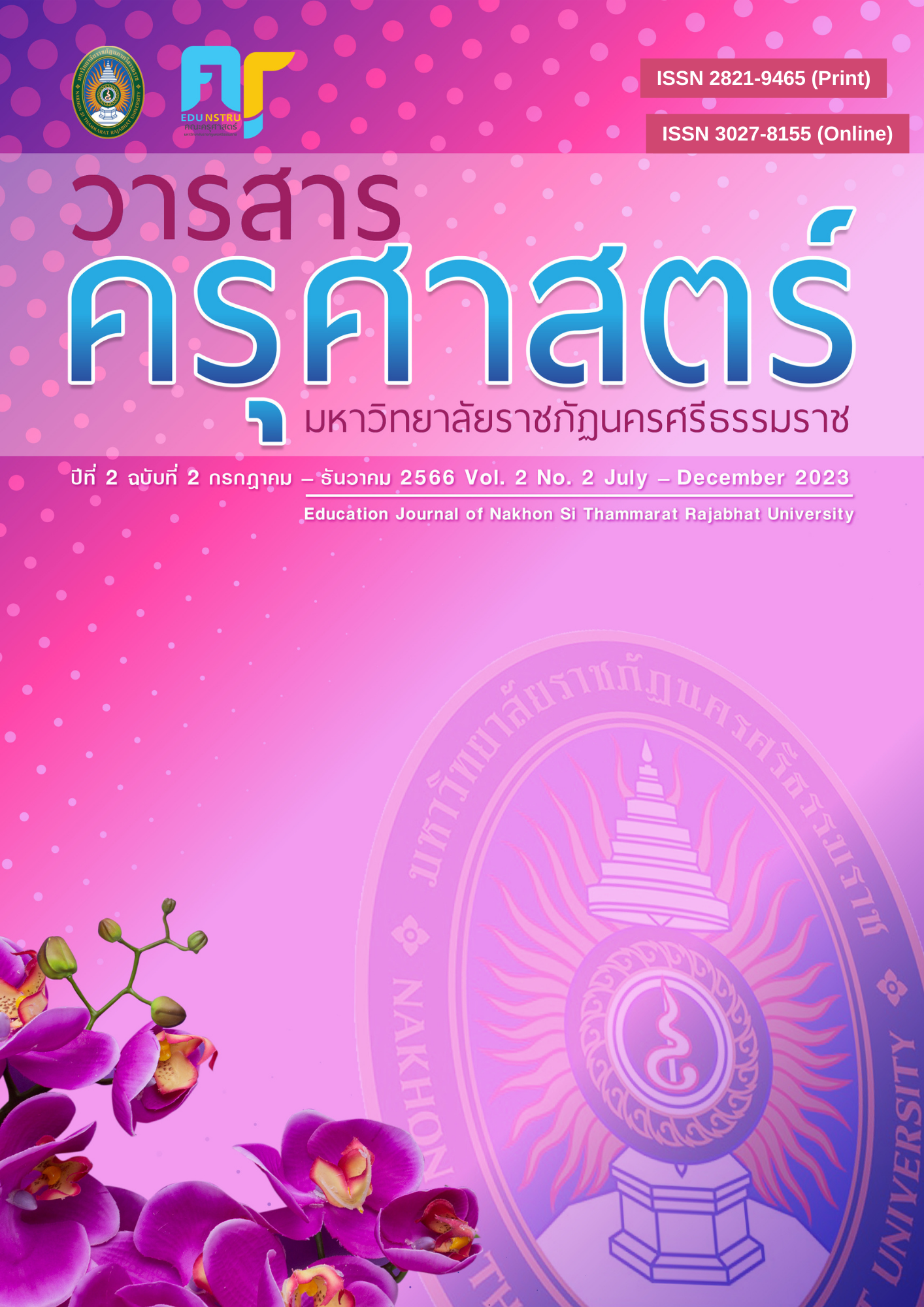การดำเนินการเชิงเศษส่วนของนักเรียนระดับชั้นประถมศึกษาปีที่ 4 ในชั้นเรียนที่จัดการเรียนรู้ด้วยวิธีการแบบเปิด
Main Article Content
บทคัดย่อ
การวิจัยครั้งนี้มีวัตถุประสงค์เพื่อศึกษาการดำเนินการเชิงเศษส่วนของนักเรียนชั้นประถมศึกษาปีที่ 4ในชั้นเรียนที่จัดการเรียนรู้ด้วยวิธีการแบบเปิด การวิจัยนี้ใช้ระเบียบวิธีการวิจัยเชิงคุณภาพ ได้แก่ การสังเกตอย่างมีส่วนร่วมและการทดลองเชิงการสอน กลุ่มเป้าหมาย คือ นักเรียนชั้นประถมศึกษาปีที่ 4 จำนวน 26 คน โรงเรียนเทศบาลวัดขจรรังสรรค์ จังหวัดภูเก็ต ซึ่งเป็นโรงเรียนที่ใช้นวัตกรรมการศึกษาชั้นเรียนและวิธีการแบบเปิดตั้งแต่ปีการศึกษา 2563 เครื่องมือที่ใช้ในการวิจัย คือ แผนการจัดการเรียนรู้เรื่อง เศษส่วน จำนวน 5 แผน กล้องวีดิทัศน์ กล้องภาพนิ่ง เครื่องบันทึกเสียงและแบบบันทึกภาคสนาม การเก็บรวบรวมในภาคเรียนที่ 2 ปีการศึกษา 2565 โดยบันทึกเสียงและวีดิทัศน์ และบันทึกภาคสนาม วิเคราะห์ข้อมูลโดยการวิเคราะห์โพรโทคอลและการบรรยายเชิงวิเคราะห์ตามกรอบแนวคิดเชิงทฤษฎีของ Steffe & Olive (2010)
ผลการวิจัยพบว่า ในชั้นเรียนที่จัดการเรียนรู้ด้วยวิธีการแบบเปิด นักเรียนมีการดำเนินการเชิงเศษส่วน ดังนี้ 1) นักเรียนระบุปริมาณทั้งหมดและหน่วยได้จากการพับกระดาษและเทน้ำ 2) นักเรียนจำแนกหน่วยและปริมาณทั้งหมดในส่วนที่เท่ากันจากการพับกระดาษ 3) นักเรียนจินตนาการถึงปริมาณทั้งหมดได้และอธิบายถึงปริมาณที่เกินมาได้จากการเทน้ำ 4) นักเรียนมองเห็นความสัมพันธ์ของเศษส่วนหนึ่งหน่วยกับปริมาณทั้งหมด และ 5) นักเรียนอธิบายขนาดของเศษส่วนทั้งที่เกิดจากการแยกเศษส่วนและการรวมเศษส่วน
Article Details

อนุญาตภายใต้เงื่อนไข Creative Commons Attribution-NonCommercial-NoDerivatives 4.0 International License.
บทความที่ได้รับการตีพิมพ์เป็นลิขสิทธิ์ของวารสารครุศาตร์ มหาวิทยาลัยราชภัฏนครศรีธรรมราช
ข้อความที่ปรากฏในบทความแต่ละเรื่องในวารสารวิชาการเล่มนี้เป็นความคิดเห็นส่วนตัวของผู้เขียนแต่ละท่านไม่เกี่ยวข้องกับวารสารครุศาสตร์ มหาวิทยาลัยราชภัฏนครศรีธรรมราช
เอกสารอ้างอิง
ลักษณา ต้นจันทน์, นฤมล ช่างศรี และเกียรติ แสงอรุณ. (2560, 2-4 มิถุนายน). ความเข้าใจเรื่องเศษส่วนของนักเรียนในชั้นเรียนคณิตศาสตร์ที่ใช้การศึกษาชั้นเรียนและวิธีการแบบเปิด [Paper presentation]. การประชุมวิชาการด้านคณิตศาสตร์ ครั้งที่ 20, มหาวิทยาลัยเชียงใหม่.
สุภาวดี ชัยมนตรี. (2561). การศึกษาการแสดงแทน (Representation) เกี่ยวกับเศษส่วนของนักเรียนชั้นมัธยมศึกษาปีที่ 1 [วิทยานิพนธ์ครุศาสตรมหาบัณฑิต, มหาวิทยาลัยราชภัฏมหาสารคาม]. Rajabhat Maha Sarakham University. http://fulltext.rmu.ac.th/fulltext/2561/%E0%B9%84%E0%B8%94%E0%B8%94%E0%B8%A3%E0%B8%9F%E0%B9%8C%E0%B8%89%E0%B8%B1%E0%B8%99/2%20%E0%B8%9E%E0%B8%A2.61/%5B%E0%B8%9B.%E0%B9%82%E0%B8%97%5D/124147/Chaimontree%20Supawdee.pdf
Becker, J.P. & Shimada, S. (1997). The open-ended approach: a new proposal for teaching mathematics. NCTM.
Hiebert, J. (1985). Children's knowledge of common and decimal fractions. Education and Urban Society, 17, 427-437.
Inprasitha, M. (2022). Lesson study and open approach development in Thailand: a longitudinal study. International Journal for Lesson and Learning Studies, 11(5), 1-15. https://doi.org/10.1108/IJLLS-04-2021-0029.
Kunseeda, P., Inprasitha, M., Changsri, N. & Sudjamnong, A. (2019). Students’ speaking skills in mathematics classroom using lesson study and open approach. Creative Education, 10, 1702-1712.
Mack, N.K. (1990). Learning fractions with understanding: building on informal knowledge. Journal for Research in Mathematics Education, 21, 16-32.
Mack, N.K. (1995). Confounding Whole-Number and Fraction Concepts When Building on Informal Knowledge. Journal for Research in Mathematics Education, 26(5), 422-441.
McCloskey, A.V. & Norton, A.H. Recognizing schemes, which are different from strategies, can help teachers understand their students’ thinking about fractions. Mathematics Teaching in the Middle School, 15, 44-50.
Misquitta, R. (2011). A review of the literature: fraction instruction for struggling learners in mathematics. Learning Disabilities Research & Practice, 26, 109-119.
Moss, J. & Case, T. (1999). Developing children’s understanding of the rational numbers: a new model and an experimental curriculum. Journal for Research in Mathematics Education, 30, 122-148.
Steffe, P. & Olive, J. (2010). Children’s Fractional Knowledge. Springer. DOI 10.1007/978-1-4419-0591-8


